LING-APP – A Review: Finnish, French, German, and much more
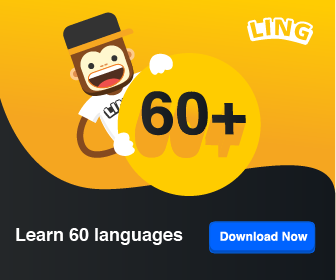 A while ago we were approached by Ling-App about reviewing their language learning app. As we like to do, we spent some time using the program to understand how it works and to see how effective it is.
A while ago we were approached by Ling-App about reviewing their language learning app. As we like to do, we spent some time using the program to understand how it works and to see how effective it is.
The Ling app has 60+ languages on its platform, many of them less commonly taught. So for me, it was a treat to choose a language I didn't know much about. I decided to focus on Finnish. The Finnish language has always intrigued me, and now, with an eye on visiting Finland in the fall of 2021, this was a perfect opportunity to learn some basics.
Besides learning Finnish, using English as the teaching language, I also looked at a couple of other languages on the app: Swedish and German, using Italian; English, using German. Peter did a number of lessons in Dutch, French, Italian and Spanish, using English and German as the teaching languages.
We'll do a general overview of the app, and wherever it fits, add a comment about the languages we tried out.
THE LING PLATFORM
The Ling app was built by Simya Solutions, Ltd. using state of the art technology (such as React and React Native).
You can download Ling on the App Store for your iPhone, iPad, and on the Play Store for your Android phone, tablet. There's also a web version: https://ling-app.com/
Ling works on the freemium model: eight lessons of each language are free. For further lessons you'll need to get a subscription (either per month, per year, or for lifetime). For specific prices, check the individual apps.
THE LING APP SETUP
The setup is logical, easy to use and intuitive. It's identical for all of the languages.
There are five (5) Levels of difficulty:
1. Beginner
2. Intermediate
3. Upper Intermediate
4. Advanced
5. Expert
Each Level has ten (10) themed Units.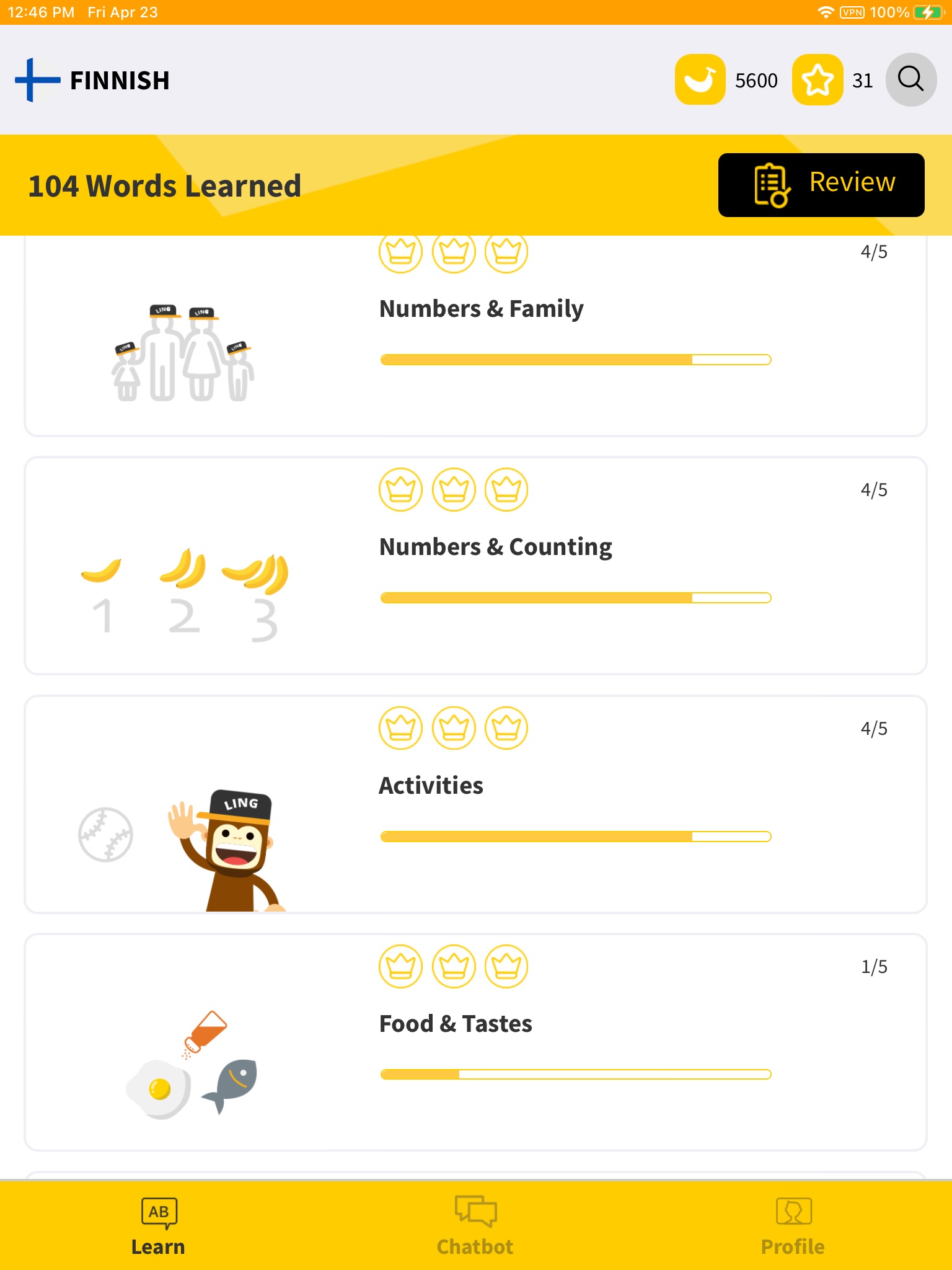
For example, the Beginner Level in each of the languages consists of:
1. Introduction
2. Basic Sentences
3. Numbers and Family
4. Numbers and Counting
5. Activities
6. Food & Tastes
7. Vegetables & Fruits
8. In the Café
9. Eating Out
10 Where is it?
Each themed Unit has four (4) Lessons. The new vocabulary items (see examples below) are all used in a sentence, which you'll also learn and be tested on.
In the Introduction Unit, you'll find the following 16 vocabulary items:
• a woman, a man, a girl, a boy
• twenty-five, twelve, fourteen, forty
• USA, Germany, China, Japan
• English, German, Chinese, Japanese
Gamified Tasks
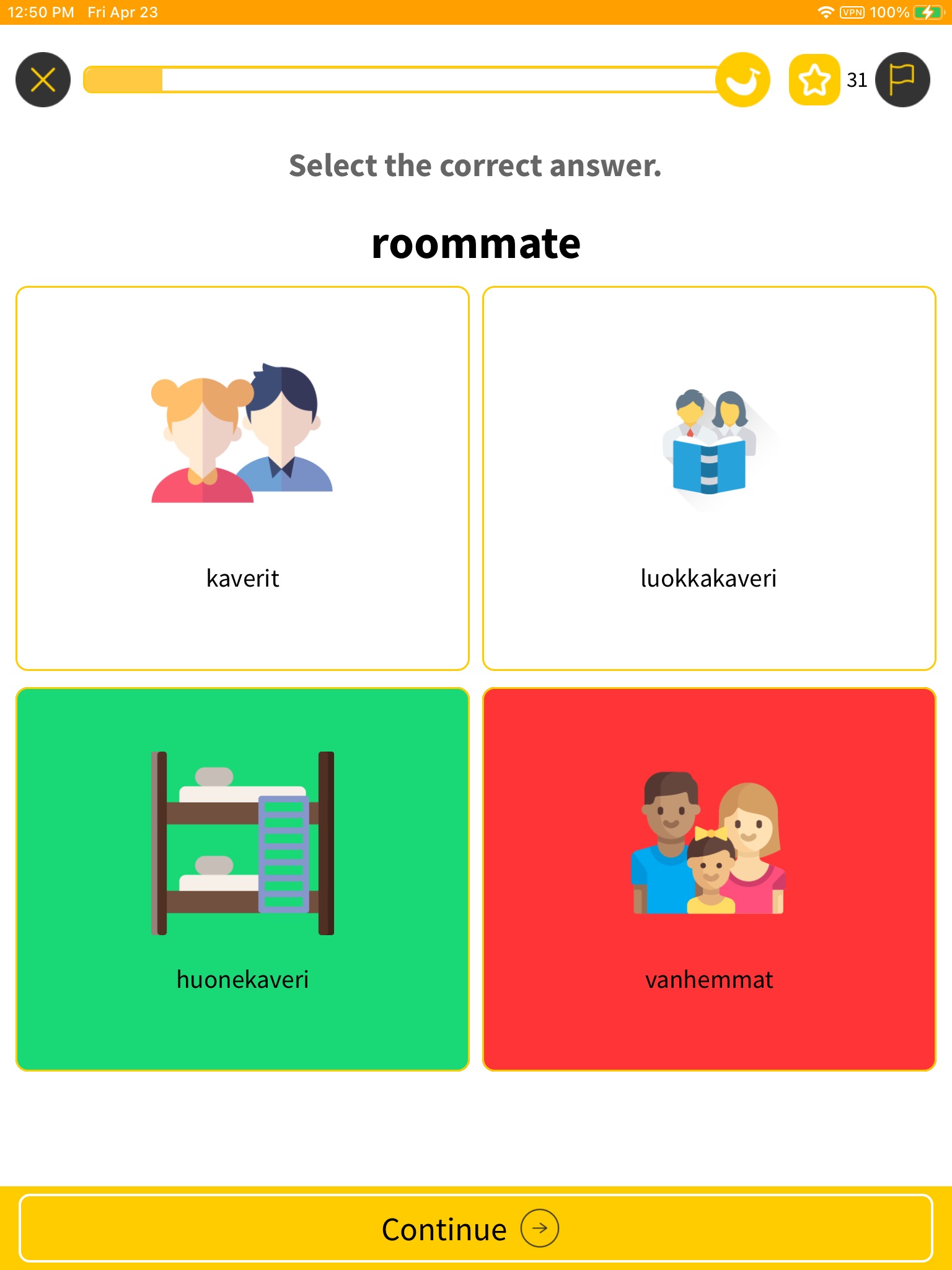 You practice the new vocabulary and sentences with gamified exercises. They all have audio and give you hints if you need them. The tasks are short and fun to do and function as quick self-tests. You'll check each answer to see if it's correct.
You practice the new vocabulary and sentences with gamified exercises. They all have audio and give you hints if you need them. The tasks are short and fun to do and function as quick self-tests. You'll check each answer to see if it's correct.
The exercises and their content are identical for each language:
• Match the card. In the screenshot I first chose the wrong word for "roommate" (red)
• What did you hear?
• Sort this Sentence.
• Translate this sentence.
• Conversation (with known vocabulary in the context of some unknown words).
• Fill the gaps (in a simplified version of the conversation).
Other Activities
You Have Learned:
At the end of the lesson, you'll see "You Have Learned": a list of the words/phrases (with a simple image) and the sentences, as they were introduced at the start of the lesson.
Review It All:
You'll see this on top of every unit and it means a review of the full unit, i.e. all 4 lessons. With the review, you'll go through flashcards with audio to review the 16+ vocabulary items and sentences. You'll also go through the 4 dialogues in the sequence that you learned them.
Courses that have grammar explanations also have a review of the 4 grammar cards from the unit.
Speaking: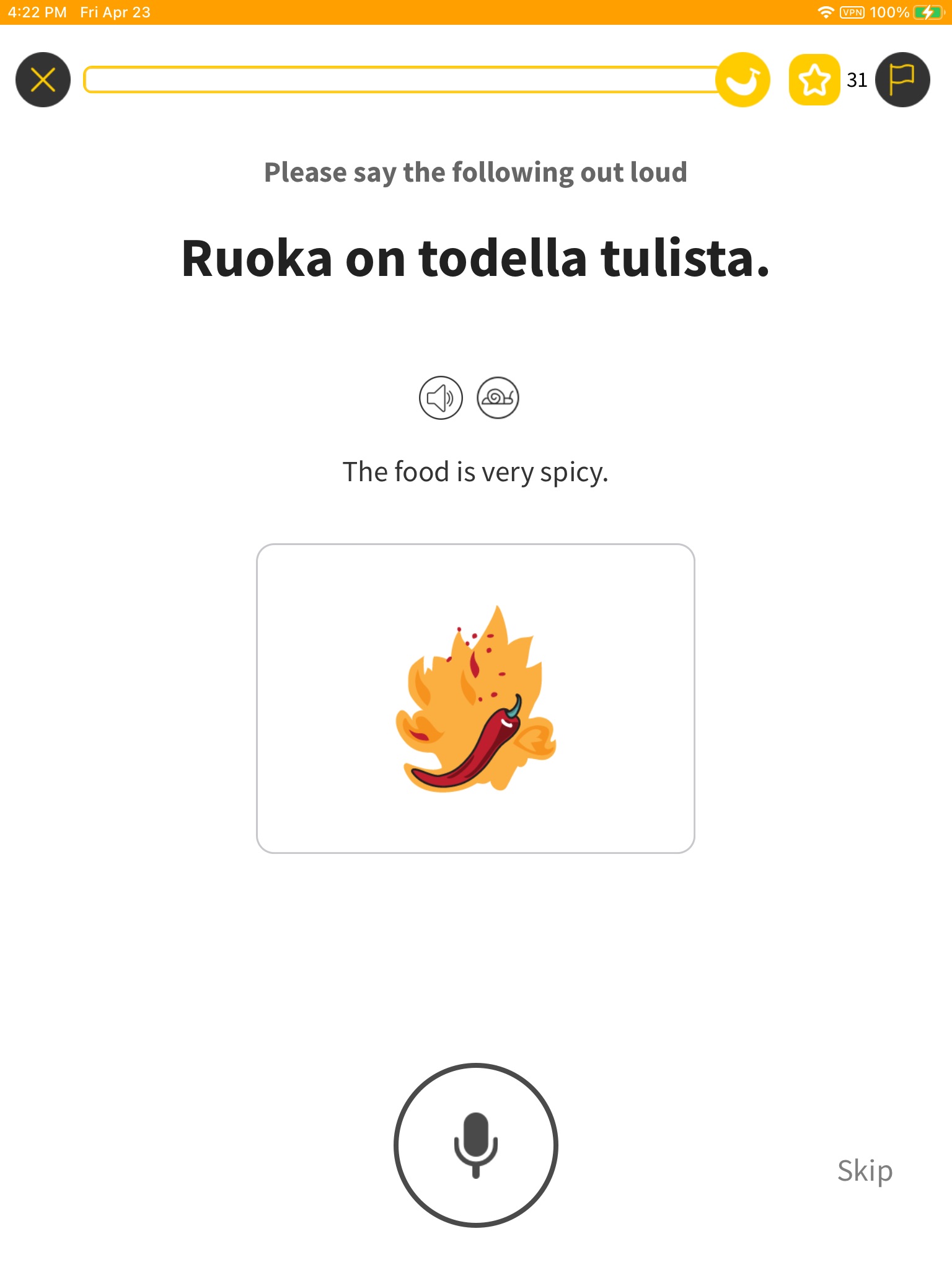 For the speaking exercise that comes with each unit on the phone and tablet app, you can first listen to the native speaker or read off a word/phrase or sentence.
For the speaking exercise that comes with each unit on the phone and tablet app, you can first listen to the native speaker or read off a word/phrase or sentence.
The speech recognition function works pretty well, as I could test with German. Swallowing my Viennese accent, I got a "perfect" score at 100% each time. Same with English.
With Finnish, I was less successful. The first sentence I got for the first Unit was long and looked complicated. I got a totally deserved "poor" rating, with 26% accuracy.
Exam:
The exam at the end of each unit consists of about 10 tasks that include:
• Pick the translation of a word or sentence into your target language, multiple choice.
• Pick the translation of a target language word or sentence into your native language, multiple choice.
• Sort the sentence.
Chatbot:
In some of the Units, you can go to the Chatbox and participate in a conversation. You either tap on a response, or just read it off. The language should be familiar to you if you've done the unit. It's a fun way to try out the language you've been learning.
VOCABULARY
What you learn on Ling is basic, practical, everyday vocabulary. Each unit introduces between 16-24 new words (that is, for the languages we tried).
You won't be dealing with sentences that are weird or cute. (Though, some sentences are less practical than others. In the 'Swedish for Italian' Unit Dove/Where?, I came across the sentence: Boken är under jordgubbelådan. Il libro è sotto la scatola delle fragole. = The book is under the box of strawberries. This is probably a sentence I'll never use.)
I like the way vocabulary is introduced: a word/phrase together with a sentence using it. So, you always have some context.
The conversation at the end of each lesson includes known words, but also words and sentences that were not taught. But they help widen your experience of the target language and you do get translations and audio.
The practice games all follow the same pattern and sequence. They are easy to do and for each of your answers you get feedback. You can request a "hint", which will make it even easier to get the answer.
You can enter the course at any lesson that you choose, and skip around as much as you want (except within a lesson itself). Also, you're not required to stick to the sequence of Units as they are presented. That's an upside.
AUDIO
For each item you learn, you have audio (recordings of native speakers). These you can play back as often as you want, either at normal speed or slowed down. The voices we heard were very pleasant.
We often play the audio of a sentence several times, both after the speaker and also with the speaker, shadowing so to speak.
GRAMMAR
It's our impression from the several languages we tried that some languages on Ling have no or very limited grammar explanations. That's probably true for the less common languages. Finnish certainly doesn't have any grammar explanations at this time.
Since all the courses teach the same vocabulary and topics and don't focus on building language-specific grammar patterns, you'll find yourself just memorizing stuff at first. That even goes for a language that does have grammar explanations, such as German.
PRICING
Subscriptions to the app may seem a little high, especially for languages that have lots of other resources, some of them totally free.
Still, when you compare the cost of the Ling app to paying for individual tutoring, the yearly Pro subscription at 4 USD/month looks like a good deal. This is especially true for languages for which resources are scarce.
WHAT WE LIKE
• You can learn many less commonly taught languages.
• It's fun to learn with Ling.
• Navigating the app is easy and intuitive.
• It's easy to replay individual audios.
• It's easy to repeat a lesson.
• You can skip around if you want
• The vocabulary is practical and useful.
• You can get reminder emails and keep your streak.
• Words/phrases are always taught together with a sentence using them.
• The native-speaker audios we tested are usually of excellent quality.
• The Chatbox is a fun way to try out conversations.
OTHER POINTS TO CONSIDER
• In the languages we know well, we noticed some errors, but you can flag them (top right flag image).
• In the Chatbox, you can choose between responses, but some of them don't make sense in the context.
• The identical setup and topics ignores some of the cultural specifics, e.g. in food, activities, customs, etc. 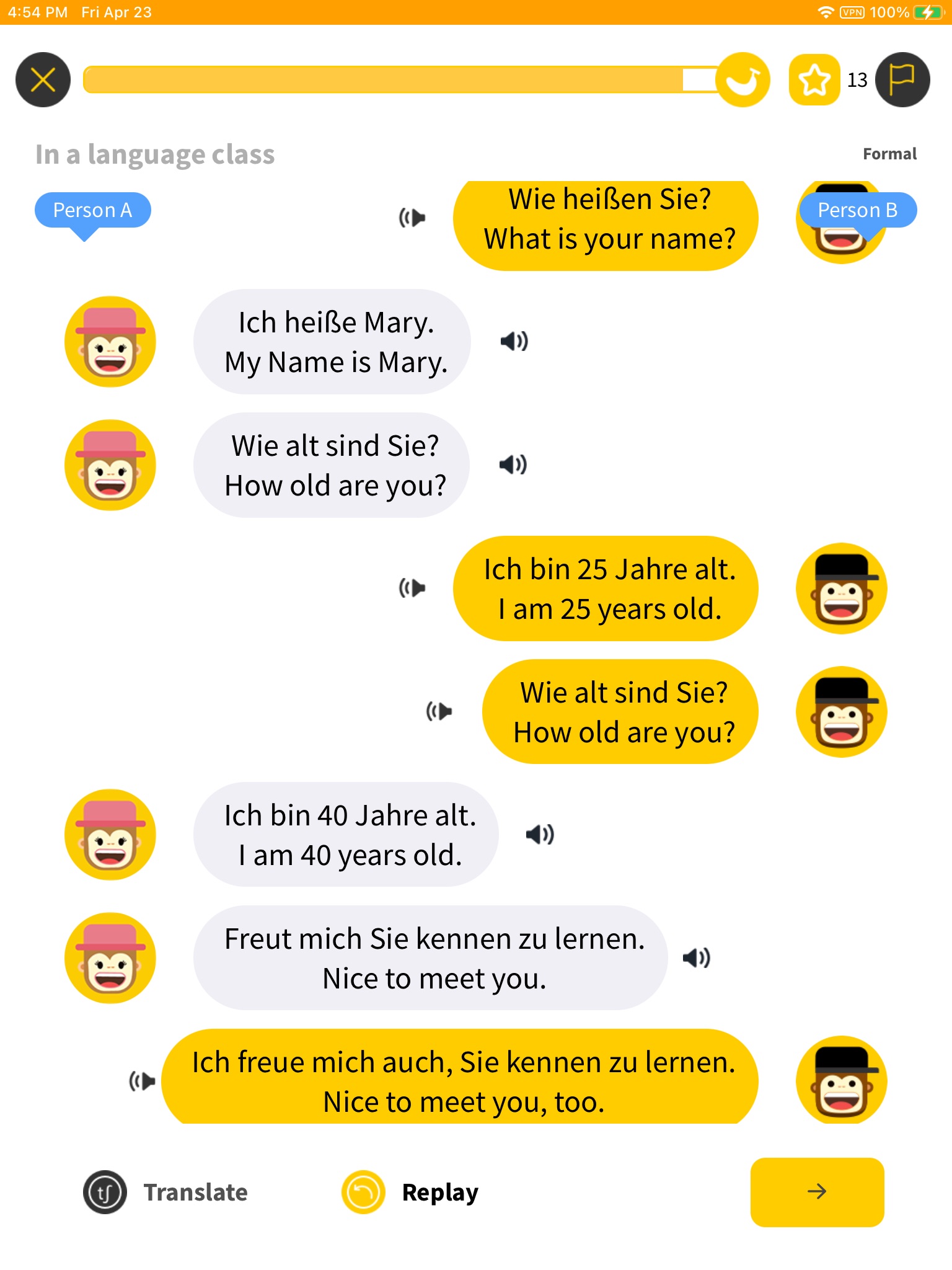 For example, in German you would not ask a person their age right after you've met them. It may be somewhat awkward in other languages, too.
For example, in German you would not ask a person their age right after you've met them. It may be somewhat awkward in other languages, too.
This is the dialogue in the second lesson:
A: Excuse me. What's your name?
B: My name is Tom. What's your name?
A: My name is Mary. How old are you?
B: I am 25 years old. How old are you?
A: I am 40 years old. Nice to meet you.
B: Nice to meet you too.
• For languages with different sounds systems, pronunciation tips would be helpful. We didn't find any yet for the languages we tried.
• You get little or no help with understanding grammar patterns, e.g. sentence structures, cases, conjugations, grammatical endings, typical idiomatic phrases. A good example is Finnish. It has 15 noun cases (indicated by its suffix), 6 of which are locative cases (for which English uses prepositions). Gradual introduction of these with an explanation would have have made learning easier.
• From Beginner to Expert - and probably because of the strict focus on vocabulary and topics - the progression in language complexity is somewhat uneven. Sometimes sentences are long and complicated, sometimes they are surprisingly simple and easy.
• Complex grammar items are sometimes bundled. In the Expert category for example, the units Wishes 1 and Wishes II, are used to introduce the future, conditional, and subjunctive verb forms.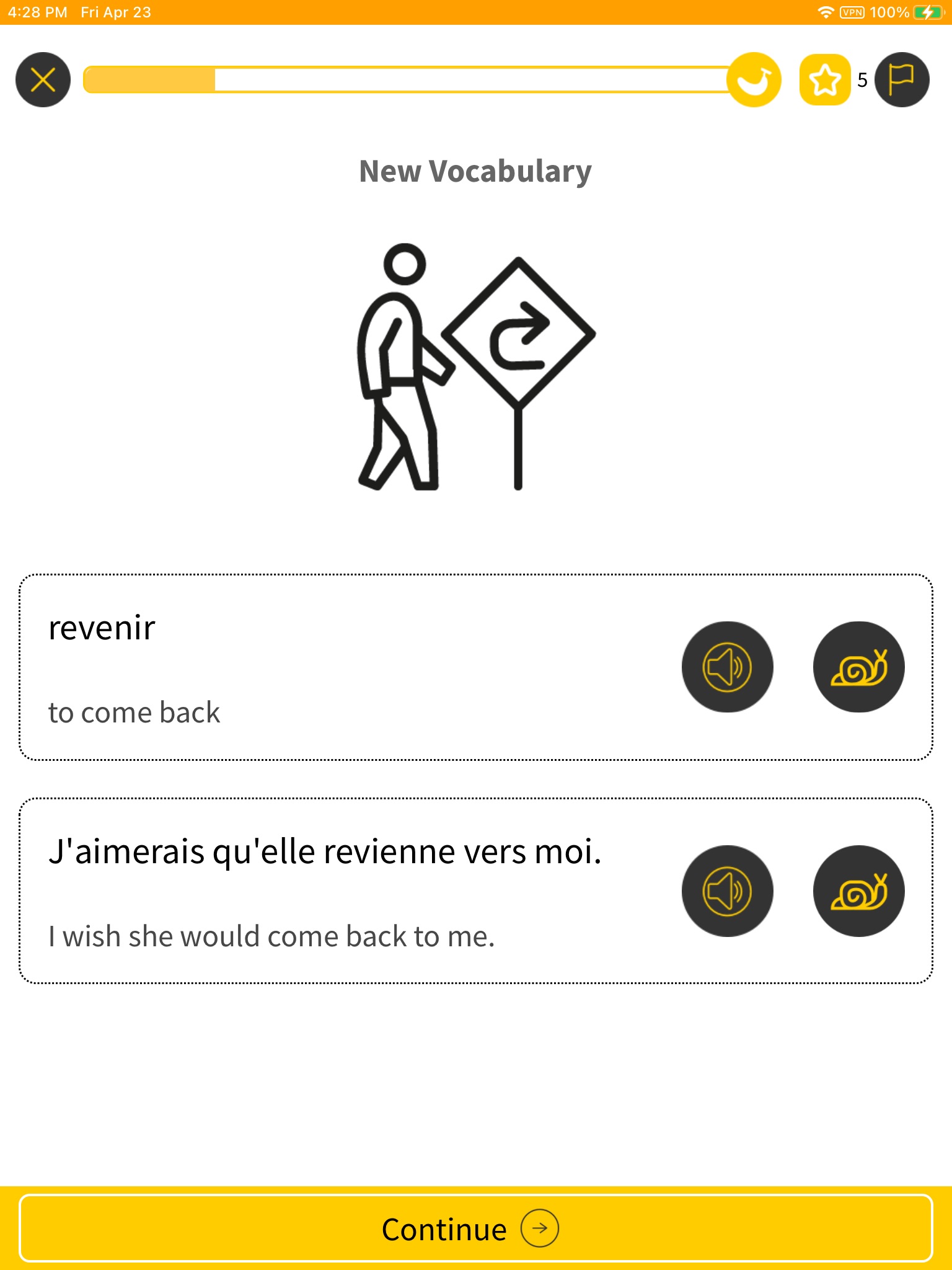 For example the English: “I wish she would come back to me.” (Unit 50) has the following forms in:
For example the English: “I wish she would come back to me.” (Unit 50) has the following forms in:
French: J'aimerais qu'elle revienne vers moi. (conditional and subjunctive)
Italian: Spero che torni indietro da me. (indicative and subjunctive)
Spanish: Desearía que ella volviese a mí. (conditional and subjunctive)
German: Ich wünschte, sie würde zu mir zurückkommen. (subj II preterite and subj II future)
You'll also notice that “I wish” is actually only used as indicative in Italian (spero), but actually translated as the conditional “I'd wish” in French, Spanish and German.
• A few different conditional and subjunctive forms of the new verbs are introduced in Unit 50. However, they are certainly not enough to learn their conjugations nor are there any explanations why and when they are used. A grammar book would therefore be quite advisable for any serious learner.
• For the web version use the Google browser is recommended, as the audio features may not work on all browsers.
Conclusion
Ling will not be the app or language program which will get you to fluency in a hurry – no app or online program really does.
The program does work well for beginners and intermediate learners or those who use it as an addition to another learning effort or method.
Its 50 lessons are well structured and fun to do, with useful and practical vocabulary, although additional grammar and pronunciation help may be needed.
Especially for languages that are less commonly spoken and taught, the Ling App platform offers some great resources.
The seamless interchangeability of target and teaching languages lets language lovers also experiment with different combinations and understand language differences, and use one target language to learn another.
Disclosure: We added Ling App to our Partner's list. For the above review we received a free 2-month subscription. Should you decide to subscribe to the Ling, Gamesforlanguage may receive a small commission which will help us keep our own site ad-free.
